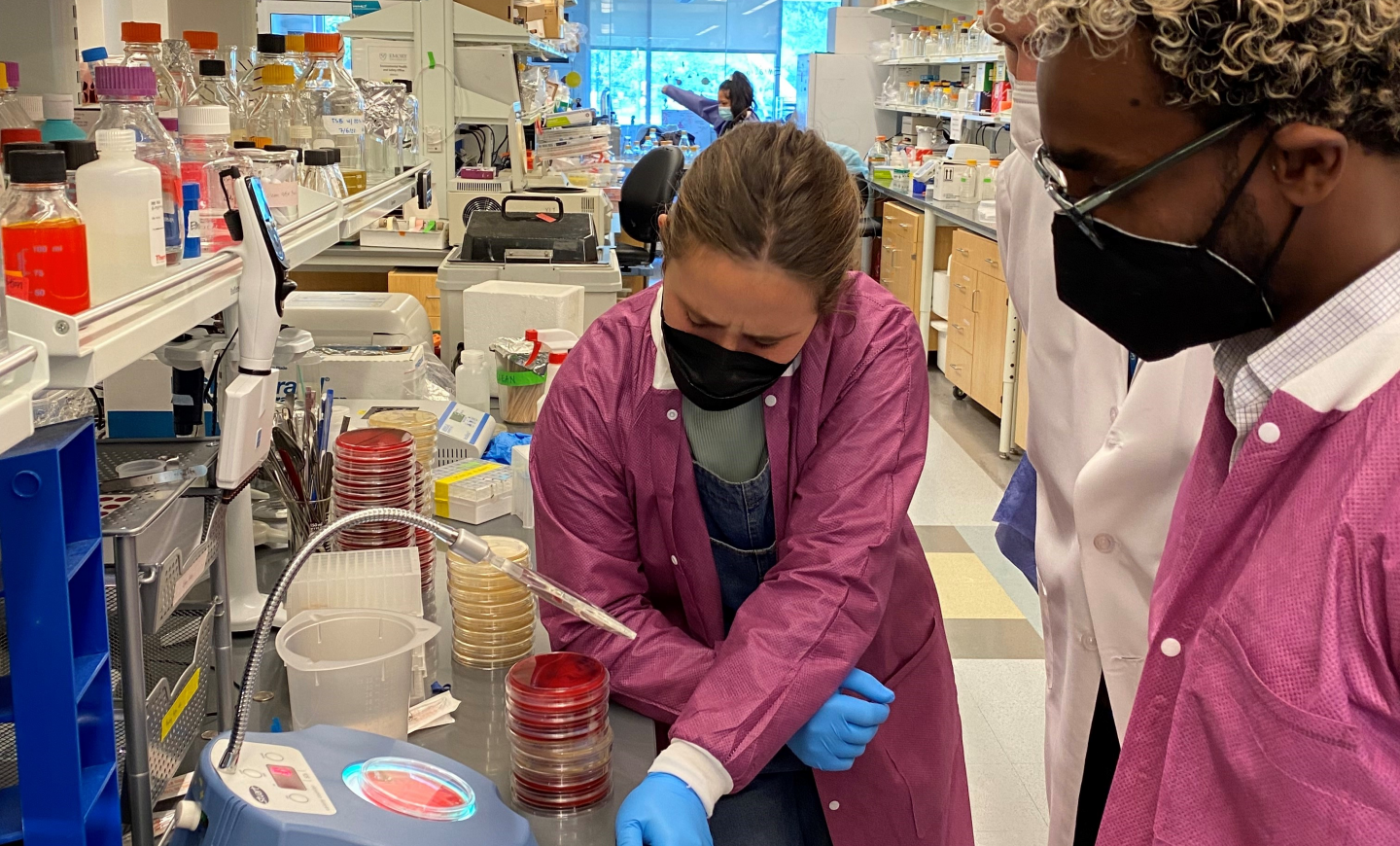Emory has been a CDC Prevention Epicenter site since 2015. The 11 current Epicenter sites include some of the top research institutions in the United States and provide PEACH investigators the opportunity to collaborate with subject matter experts from across the country. CDC’s HAI Prevention Epicenter Program conducts collaborative, multi-site research projects leveraging the network to produce geographical representative and generalizable studies.
- Duke-UNC Prevention Epicenter
- Harvard Pilgrim Health Care Institute Center for Excellence in HAI Surveillance and Prevention
- Washington University & BJC Epicenter to Prevent Healthcare Associated Infections & Antibiotic Resistance
- Johns Hopkins Prevention Epicenter: Transdisciplinary Research Approaches to Prevent Healthcare Associated Infections and Antibiotic Resistance (TRAP HAI & AR)
- The Iowa Prevention Epicenter: Infection Prevention and Antimicrobial Stewardship
- University of Maryland-Baltimore Epicenter
- University of Maryland-Baltimore
- Chicago Prevention and Intervention Epicenter (CPIE)
- Intermountain Program on Antibiotic Resistance and Microbial Threats
- Southeastern Pennsylvania Adult and Pediatric Prevention Epicenter Network
- University of Pennsylvania
- J. Craig Venter Institute and Cleveland VA Prevention and Intervention Epicenter
- J. Craig Venter Institute
- Cleveland Veterans Affairs Medical Center
HAI Prevention Epicenter research projects cover several key areas related to healthcare epidemiology and infection prevention
Activities will occur at Emory Healthcare, the largest healthcare system in metropolitan Atlanta, GA, and virtually using established research ties to a multi-state network of nursing homes, 10 other Prevention Epicenters, Georgia Emerging Infections Program, and the Georgia Department of Public Health.
MDROs
Multidrug-Resistant Organisms
Multidrug-resistant organisms (MDROs) are germs that cannot be treated with many commonly used antibiotics, often leading to poor patient outcomes. Transmission of MDROs occurs across the spectrum of healthcare settings. The prevention and control of MDROs is a national priority – one that requires that all healthcare facilities and agencies assume responsibility.
Projects: Pre-ALERT, InPART RX, FAIR, CHAMPIONS, REACT, PAINTS, RAISE
Sepsis
Treatment & Prevention
Sepsis is the body’s extreme response to an infection. It is a life-threatening medical emergency where the body’s immune system response can be as harmful as the infection itself. Sepsis happens when an infection (such as one originating from the lungs or skin) triggers a chain reaction throughout your body. Early and optimized treatment for sepsis is an aim for improving patient safety.
Projects: IMPRESS
Antibiotic Stewardship
Promoting Best Antibiotic Prescribing
Antibiotic stewardship is the effort to measure and improve how antibiotics are prescribed by clinicians and used by patients. Improving antibiotic prescribing is critical to effectively maintain our ability to treat infections and protect patients from harms caused by unnecessary antibiotic use. In essence, antibiotic stewardship is promoting the right antibiotic for the right indication for the right duration for a given patient.
Projects: InPART RX, BCx Stewardship, EASIL
Novel Settings
Study Across the Spectrum of Healthcare Delivery
Over the past decade, healthcare epidemiology has shifted from a primary focus on acute care hospitals to many other settings including outpatient dialysis facilities, skilled nursing facilities (SNFs), long-term acute care hospitals (LTACHs), inpatient rehabilitation hospitals, and ambulatory centers. Healthcare-associated infections (HAIs) and MDROs occur throughout the spectrum of healthcare and therefore research across these diverse settings is critical to prevent spread of these pathogens.
Projects: CHAMPIONS, REACT, PAINTS, EASIL
Microbiome
Characterization & Manipulation
Unique microbial environments located in the human body, called “microbiomes,” exist with varying bacterial compositions located across the human body from the gut to the lungs to the skin. These microbiomes play an important role in developing diseases such as sepsis, necrotizing enterocolitis, or infections with MDROs. In recent years, fecal microbiota transplantation (FMT), also known as microbiome therapeutics, has garnered increased attention to treat a wide range of diseases, such as C. difficile and MDRO infections.
Projects:
Human Factors and Environmental Microbiology
Impact of the healthcare environment on patient-worker interactions
Human factors engineering (HFE) studies how humans interact with systems (including physical and organizational environments). Applied to healthcare, HFE provides principles and techniques to systematically identify factors that increase or decrease the risk of healthcare associated infections (HAIs) and identify effective preventative measures. Environmental microbiology is the study of how potential pathogens spread to the physical environment; linking HFE and environmental biology is key to understanding pathogen transmission and prevention in healthcare.
Projects: FAIR, CHAMPIONS, REACT, FACE MDRO, CLEAN HEME
The PEACH team has a diverse skill set, including subject matter experts throughout the applied sciences, along with experienced project managers.
Jack Alperstein
Graduate Research Assistant
Radhika Asrani
Epidemiologist
Ahmed Babiker
Co-Investigator CLEAN HEME, RAISE, FAIR
Chris Bower
Program Manager
Shamie Das
IMPRESS Co-Investigator
Trey Evans
Graduate Research Assistant
Scott Fridkin
Co-Principal Investigator
Lindsey Gottlieb
RAISE Lead Investigator
Jessica Howard-Anderson
Pre-ALERT Lead Investigator
Jesse Jacob
Co-Principal Investigator
Joe Kellogg
Project Manager
Haley Liakakos
Graduate Research Assistant
Christina Mehta
Statistical Advisor
Joel Mumma
CHAMPIONS Lead Investigator
Carmen Polito
IMPRESS Lead Investigator
Rachel Regina
Project Manager
Sarah Satola
ICMC Lab Director
Amanda Strudwick
Clinical Research Nurse
Jay Varkey
CLEAN HEME Co-Investigator
Jeff Whatley
Graduate Research Assistant
Zanthia Wiley
INPART RX Co-Investigator
Michael Woodworth
FAIR and REACT Lead Investigator
Variations in the arch of the aorta and aortic valves among fetal, cadaveric, and post-mortem specimens present a spectrum of anatomical configurations, posing challenges in establishing a standard norm. While some variations hold surgical significance, many bear little functional consequence but provide insights into embryological origins. The aortic arch exhibits diverse branching patterns, including common trunks and different orders, relevant for endovascular surgeries. Meanwhile,...
Collaboration outside of CDC's Core EPIcenters is also a critical part of the PEACH program. Leveraging all the expertise throughout Atlanta, the Public Health Capital of the world, helps diversify efforts and create connection that would not be otherwise possible.
























